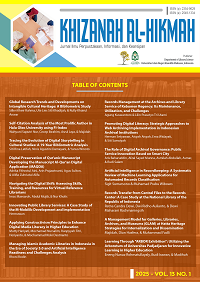Tracing the Evolution of Digital Storytelling in Cultural Studies
A 19-Year Bibliometric Analysis
DOI:
https://doi.org/10.24252/v13i1a3Keywords:
Bibliometric, Digital Storytelling, Knowledge Mapping, Cultural StudiesAbstract
This study aims to analyze the production and scholarly trends of Scopus-indexed scientific research on digital storytelling in the context of cultural studies using a bibliometric approach. Data were analyzed using Bibliometrix-R through the Biblioshiny interface and visualized with VOSviewer (version 1.6.20). The findings indicate that scholarly attention to digital storytelling peaked in 2019, with the highest average citations per article at 3.83. However, average citation rates declined in subsequent years, reaching 1.92 in 2023 and 0.79 in 2024. Among contributing scholars, Benmayor received the highest citation count for the article titled “Digital storytelling as a signature pedagogy for the new humanities” published in Arts and Humanities in Higher Education in 2008. Keyword analysis reveals that “digital storytelling,” “storytelling,” and “human” are the most frequently occurring terms, reflecting core thematic concerns in this field. These results suggest a sustained yet evolving interest in digital storytelling within cultural studies, and they underscore the need for further research on its pedagogical and cultural implications in contemporary discourse.
Downloads
References
Adams-Santos, D. (2020). “Something a Bit More Personal”: Digital Storytelling and Intimacy among Queer Black Women. Sexualities, 23(8), 1434–1456. https://doi.org/10.1177/1363460720902720
Affrida, E. N., Fachrurrazi, A., Anggreni, M. A., Masan, S. B., Karma, M. A., & Yusirianti, I. M. (2024). Mengembangkan Modul Ajar Digital Story Telling Berbasis Budaya Lokal. Pedamas (Pengabdian Kepada Masyarakat), 2(04), 1102–1106. https://pekatpkm.my.id/index.php/JP/article/view/383
Anwar, R. K., Rukmana, E. N., Saepudin, E., Khadijah, U. L. S., & Vanamamalai, R. (2023). Meaning of storytelling in volunteers’ experiences at Pabukon Ngadongeng Community Reading Park. Jurnal Kajian Informasi & Perpustakaan, 11(2), 269. https://doi.org/10.24198/jkip.v11i2.49905
Avci, A., & Kasimi, Y. (2023). A Bibliometric Analysis of Digital Storytelling in Language Education. The Literacy Trek, 9(1), 88–104. https://doi.org/10.47216/literacytrek.1294089
Avery, L. M., & Hains, B. J. (2017). Oral Traditions: A Contextual Framework for Complex Science Concepts—laying the Foundation for a Paradigm of Promise in Rural Science Education. Cultural Studies of Science Education, 12(1), 129–166. https://doi.org/10.1007/s11422-016-9761-5
Benmayor, R. (2008). Digital Storytelling as a Signature Pedagogy for the New Humanities. Arts and Humanities in Higher Education, 7(2), 188–204. https://doi.org/10.1177/1474022208088648
Benmayor, R. (2012). Digital Testimonio as a Signature Pedagogy for Latin@ Studies. Equity & Excellence in Education, 45(3), 507–524. https://doi.org/10.1080/10665684.2012.698180
Botfield, J. R., Newman, C. E., Lenette, C., Albury, K., & Zwi, A. B. (2018). Using Digital Storytelling to Promote the Sexual Health and Well-being of Migrant and Refugee Young People: A Scoping Review. Health Education Journal, 77(7), 735–748. https://doi.org/10.1177/0017896917745568
Dagiene, E., & Xie, Q. (2021). Visualising quantitative data with VOSviewer will widen your research projects. https://doi.org/10.59350/3ft5b-0kr95
Farkaš, I. (2024). Transforming Cognition and Human Society in the Digital Age. Biological Theory, 1–13. https://doi.org/10.1007/s13752-024-00483-3
Febrina, A. (2021). Penerapan Metode Storytelling untuk Meningkatkan Percaya Diri dan Kemampuan Berbicara Siswa (Studi pada Kelas X Mata Pelajaran Bahasa Inggris di SMA Negeri 1 Pagar Alam). Diadik: Jurnal Ilmiah Teknologi Pendidikan, 11(1), 88–99. https://doi.org/10.33369/diadik.v11i1.18371
Gubrium, A., Fiddian-Green, A., Lowe, S., DiFulvio, G., & Peterson, J. (2019). Digital storytelling as critical narrative intervention with adolescent women of Puerto Rican descent. Critical Public Health, 29(3), 290–301. https://doi.org/10.1080/09581596.2018.1451622
Guo, X. (2022). On the Interdisciplinary Characteristics of Cultural Studies. Journal of Innovation and Social Science Research, 9(4). https://doi.org/10.53469/jissr.2022.09(04).09
Gupta, B. M., & Dhawan, S. M. (2024). Bibliometrics Research in India: A Quantitative and Qualitative Assessment of Publications during 2014-23. Journal of Data Science, Informetrics, and Citation Studies, 3(1), 69–89. https://doi.org/10.5530/jcitation.3.1.8
Harahap, T. R., Nasution, B., Nasution, F., & Harahap, A. N. (2024). Digital Narratives: The Evolution of Storytelling Techniques in the Age of Social Media. International Journal of Educational Research Excellence (IJERE), 3(2), 738–745. https://doi.org/10.55299/ijere.v3i2.1004
Kalenge, M. (2022). Endogenous Environmental Conservation Awareness in Sangu Oral Tales. Journal of The Geographical Association Of Tanzania, 42(2), 53–69. https://doi.org/10.56279/jgat.v42i2.186
Lazarides, M. K., Lazaridou, I.-Z., & Papanas, N. (2023). Bibliometric Analysis: Bridging Informatics With Science. The International Journal of Lower Extremity Wounds, 153473462311535. https://doi.org/10.1177/15347346231153538
Maliha, H. (2024). A Review on Bibliometric Application Software. Scientometrics Letters, 1(1). https://doi.org/10.58968/sl.v1i1.458
Maulidiya, D., Nugroho, B., Santoso, H. B., & Hasibuan, Z. A. (2024). Thematic Evolution of Smart Learning Environments, Insights and Directions from a 20-Year Research Milestones: A Bibliometric Analysis. Heliyon, 10(5), e26191. https://doi.org/10.1016/j.heliyon.2024.e26191
Najla, A. P., Izzati, N. V., Oktaviani, D., & Marini, A. (2022). Digital Storytelling untuk Meningkatkan Karakter Siswa SD pada Kurikulum “Merdeka Belajar.” Jurnal Pendidikan Dasar Dan Sosial Humaniora, 2(2), 413–424. https://doi.org/10.53625/jpdsh.v2i2.4178
Nosrati, F., Crippa, C., & Detlor, B. (2018). Connecting people with city cultural heritage through proximity-based digital storytelling. Journal of Librarianship and Information Science, 50(3), 264–274. https://doi.org/10.1177/0961000618769972
Oakley, G., Pegrum, M., Xiong, X. B., Lim, C. P., & Yan, H. (2018). An online Chinese-Australian language and cultural exchange through digital storytelling. Language, Culture and Curriculum, 31(2), 128–149. https://doi.org/10.1080/07908318.2017.1386193
Ojedele-Adejumo, T. (2023). Folkloric Tradition as an Epistemology of Environmental Justice. Proceedings of the 41st ACM International Conference on Design of Communication, 49–54. https://doi.org/10.1145/3615335.3623010
Putri, R. D., Purwanto, E., Keyla, N., Nur Kharismatika, R., & Muthmainah, K. A. (2024). Identitas Budaya dalam Era Digital. El-Mujtama: Jurnal Pengabdian Masyarakat, 4(4), 2000–2011. https://doi.org/10.47467/elmujtama.v4i4.3380
Sohrabi, C., Franchi, T., Mathew, G., Kerwan, A., Nicola, M., Griffin, M., Agha, M., & Agha, R. (2021). PRISMA 2020 statement: What’s new and the importance of reporting guidelines. International Journal of Surgery, 88, 105918. https://doi.org/10.1016/j.ijsu.2021.105918
Vecchio, L., Dhillon, K. K., & Ulmer, J. B. (2017). Visual Methodologies for Research With Refugee Youth. Intercultural Education, 28(2), 131–142. https://doi.org/10.1080/14675986.2017.1294852
VijayaKumari, K. (2018). Oral Tradition as Source of Construction of History of Pre Literate Societies. Asian Review of Social Sciences, 7(3), 140–142. https://doi.org/10.51983/arss-2018.7.3.1454
Wu, J., & Chen, D.-T. V. (2020). A Systematic Review of Educational Digital Storytelling. Computers & Education, 147, 103786. https://doi.org/10.1016/j.compedu.2019.103786
Downloads
Published
How to Cite
Issue
Section
License
Copyright (c) 2025 Siti Rina Latifah, Ninis Agustini Damayani, Yunus Winoto

This work is licensed under a Creative Commons Attribution-NonCommercial-ShareAlike 4.0 International License.
By submitting your manuscript to our journal, you are following Copyright and License



